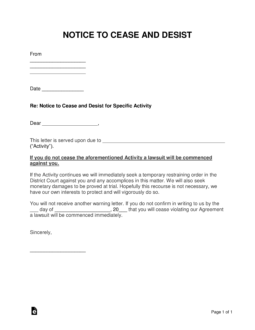Updated September 18, 2023
A cease and desist letter is used to stop an individual or entity from continuing a specified action. This is commonly the last resort before an injunction — or a court order — is filed. The letter should reveal the grounds of the claim and the infringing party’s right to cure the issue. If they continue the actions stated in the letter, an injunction may be filed in a court of proper jurisdiction.
Certified Mail with Return Receipt – Highly recommended to verify that the letter was delivered. This receipt may be used later if a lawsuit is filed to show that the defendant had issued the notice.
Table of Contents |
By Type (9)
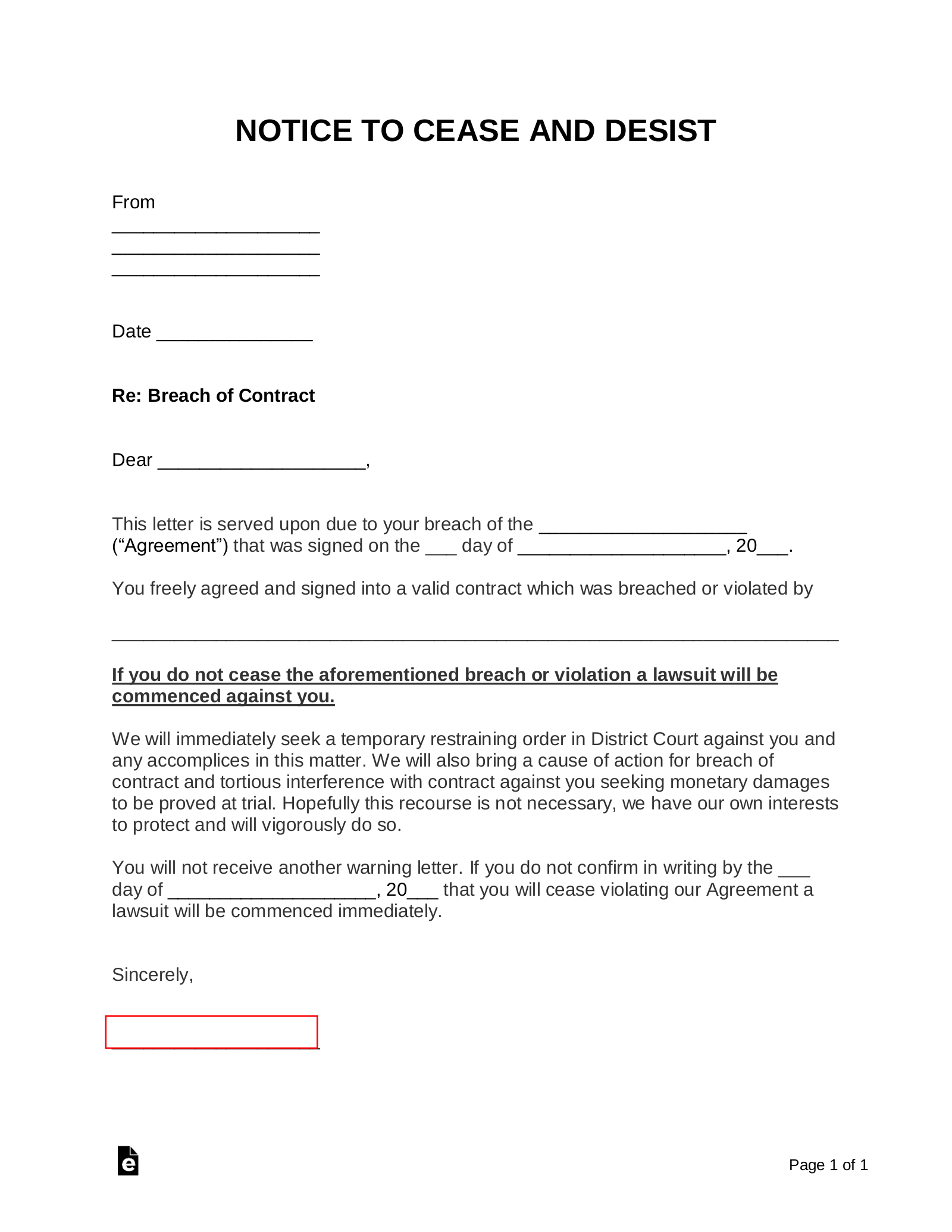 Breach of Contract Cease and Desist – Used to notify a party acting in noncompliance with an active agreement. Breach of Contract Cease and Desist – Used to notify a party acting in noncompliance with an active agreement.
Download: PDF, MS Word, OpenDocument |
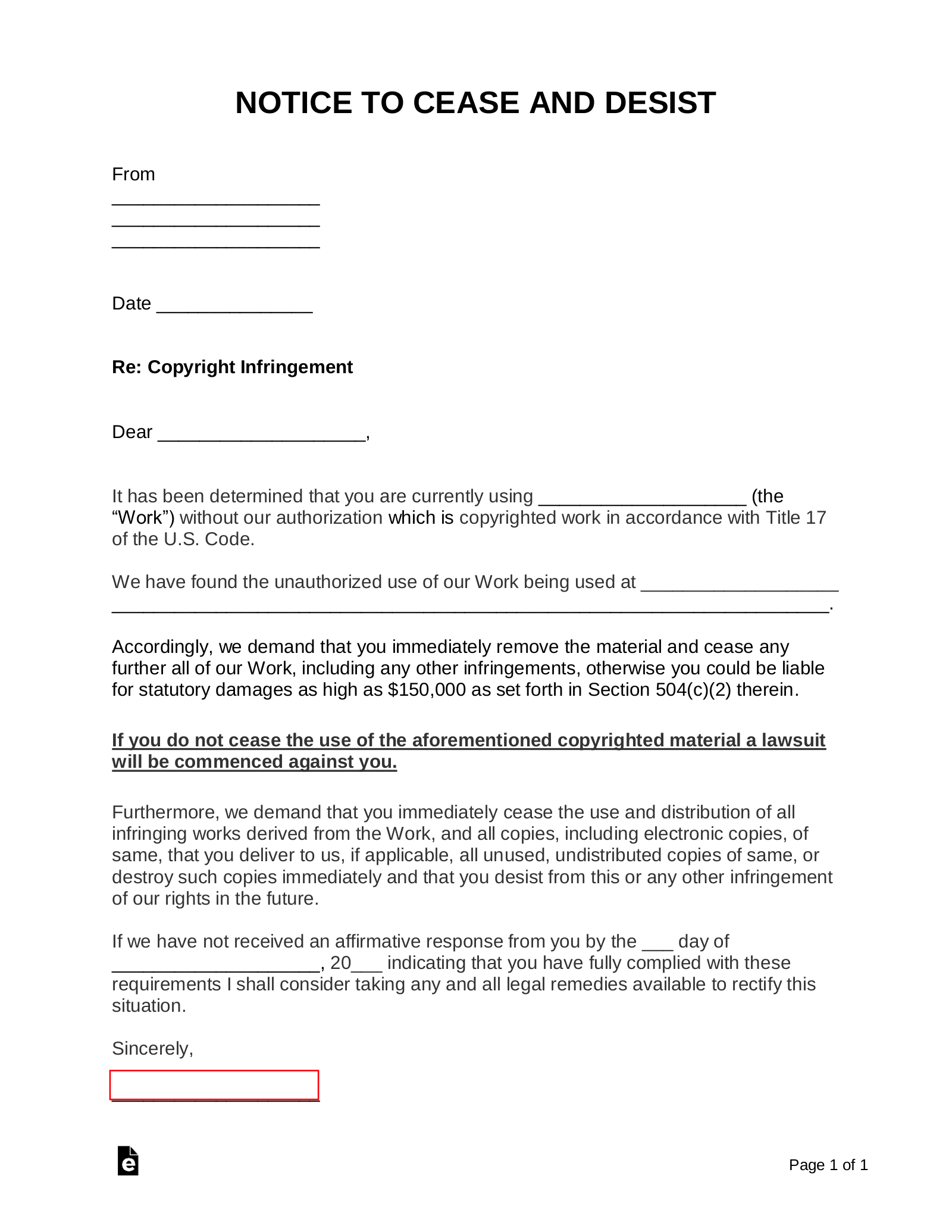 Copyright Infringement Cease and Desist – Legally informs an individual or entity of their unauthorized use of copyrighted material. Copyright Infringement Cease and Desist – Legally informs an individual or entity of their unauthorized use of copyrighted material.
Download: PDF, MS Word, OpenDocument |
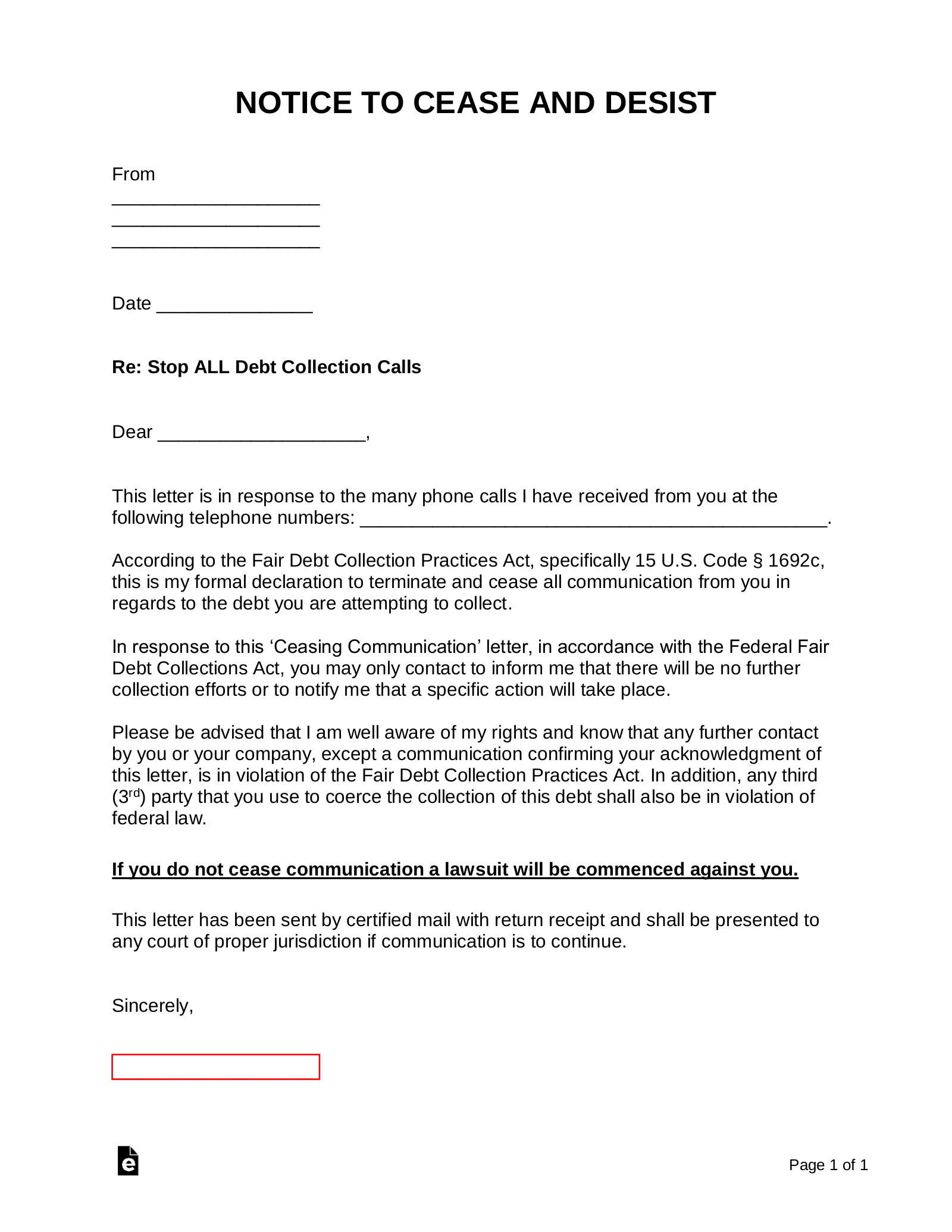 Debt Collector (Creditor) Cease and Desist – Informs a creditor to halt all forms of communication, primarily over the phone, with regard to a debt that is owed. Debt Collector (Creditor) Cease and Desist – Informs a creditor to halt all forms of communication, primarily over the phone, with regard to a debt that is owed.
Download: PDF, MS Word, OpenDocument |
 Defamation (Slander) Cease and Desist – GRequests someone to cease making false statements to harm an individual or entity. Defamation (Slander) Cease and Desist – GRequests someone to cease making false statements to harm an individual or entity.
Download: PDF, MS Word, OpenDocument |
 Harassment Cease and Desist – Takes action against inappropriate behavior (e.g. sexual comments, personal attacks, emotional abuse, etc.) by sending this as a last warning before legal action is taken. Harassment Cease and Desist – Takes action against inappropriate behavior (e.g. sexual comments, personal attacks, emotional abuse, etc.) by sending this as a last warning before legal action is taken.
Download: PDF, MS Word, OpenDocument |
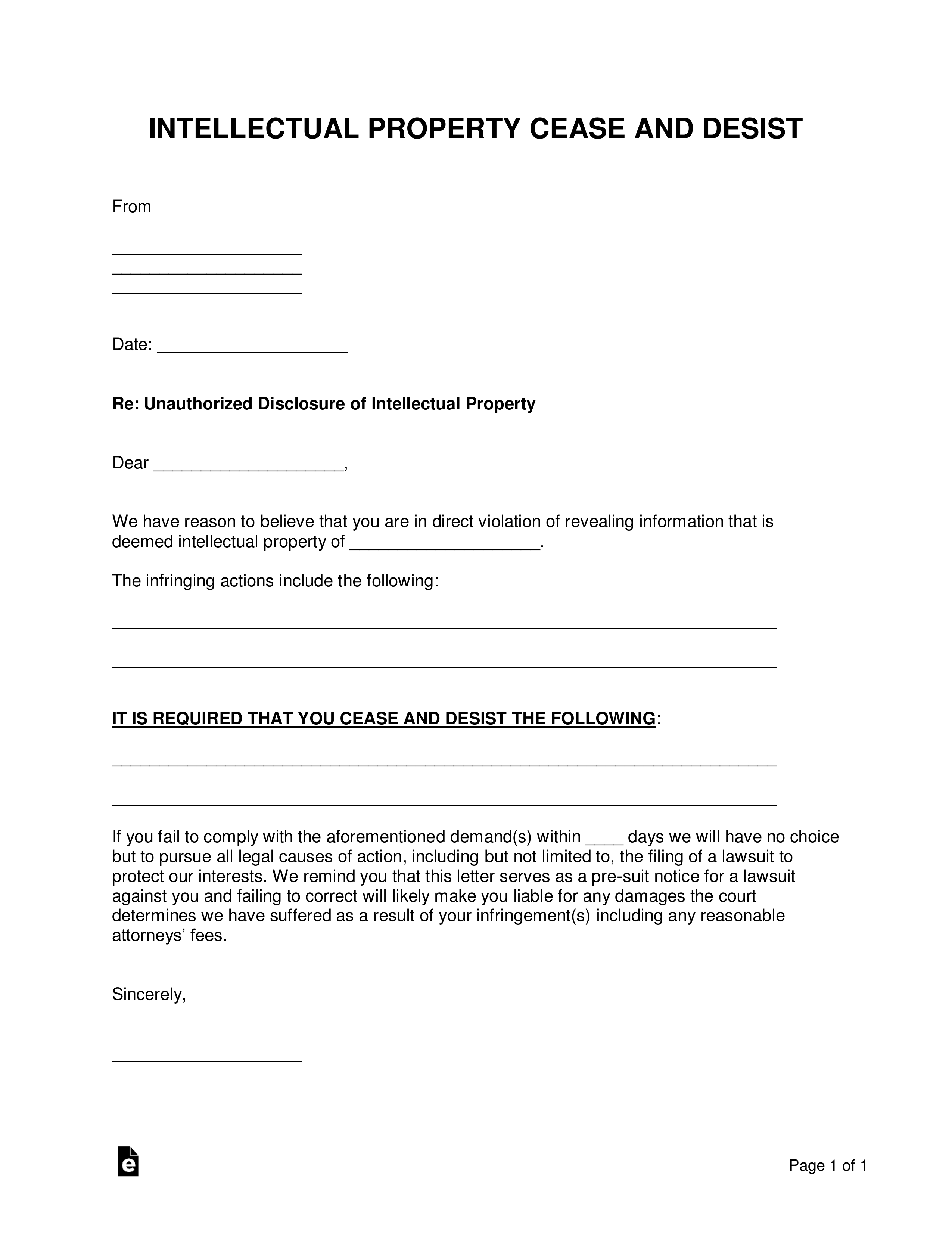 Intellectual Property Cease and Desist – Used for any type of proprietary information employed without the authorization of its owner. Intellectual Property Cease and Desist – Used for any type of proprietary information employed without the authorization of its owner.
Download: PDF, MS Word, OpenDocument |
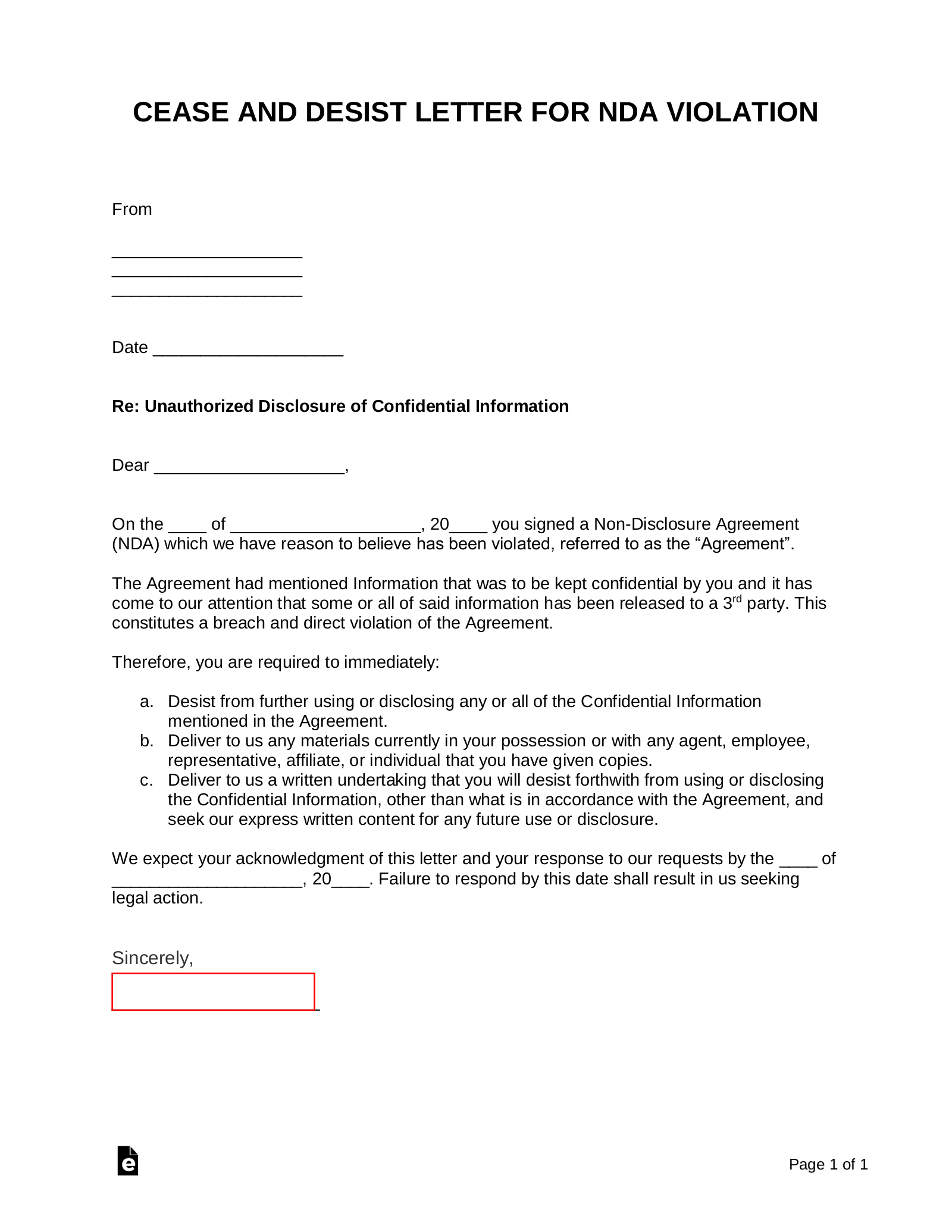 Non-Disclosure (NDA) Violation Cease and Desist – Notifies a party about their breach of an NDA. Non-Disclosure (NDA) Violation Cease and Desist – Notifies a party about their breach of an NDA.
Download: PDF, MS Word, OpenDocument |
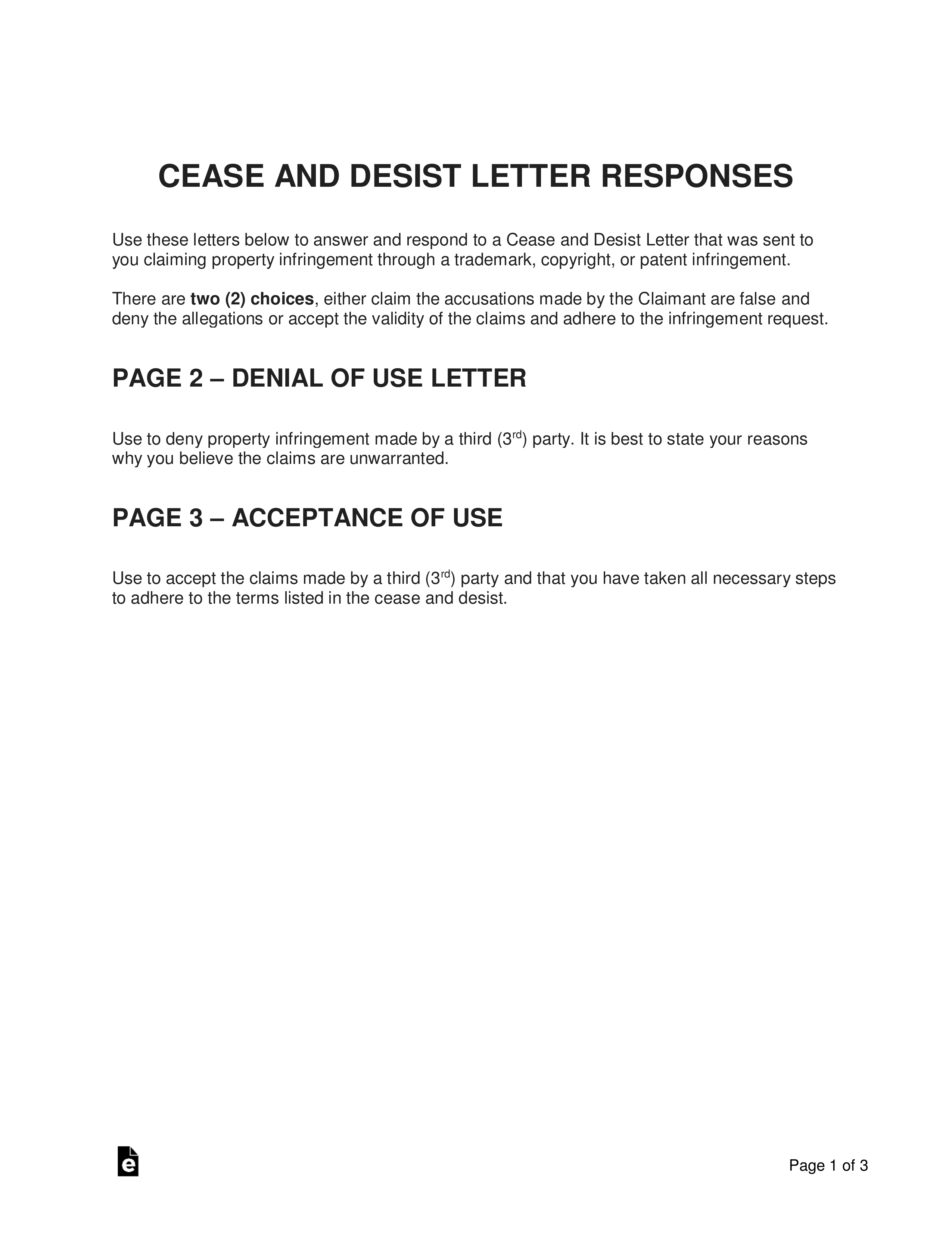 Response to Cease and Desist – Used by the recipient to officially respond to a cease-and-desist letter. Response to Cease and Desist – Used by the recipient to officially respond to a cease-and-desist letter.
Download: PDF, MS Word, OpenDocument |
 Trademark Infringement Cease and Desist – Gives official notice to a third party that is infringing on a federally registered trademark. Trademark Infringement Cease and Desist – Gives official notice to a third party that is infringing on a federally registered trademark.
Download: PDF, MS Word, OpenDocument |
What Does “Cease and Desist” Mean?
The word “cease” means to stop doing something and “desist” is to abstain from doing it further. Therefore, the term “cease and desist” is a formal declaration to immediately halt whatever that party is doing now and in the future.
What is a Cease-and-Desist Order?
A cease and desist order, or “injunction,” is issued by a court or government agency to an individual or entity to stop whatever it is they are violating. Unlike a cease and desist letter, the order is a legal judgment that places an injunction on the violator’s activities, and if not abided, may result in criminal prosecution or severe monetary damages. After a cease and desist order has been placed, any violation of said order would be an implication in illegal activity.
Cease and Desist Letter vs. Order
A cease and desist letter:
- can be written by anyone;
- asks the recipient to immediately stop what they are doing;
- recipient responds to the letter’s issuer; and
- recipient may legally continue their actions after issuance (although this may be deemed illegal at a later time).
A cease and desist order:
- can only be written by a court or government agency;
- requires the recipient to immediately stop whatever they are doing;
- recipient responds to the court or government agency; and
- recipient may not legally continue their actions after issuance.
How It Works
When writing a cease and desist letter, the goal is to have the recipient feel the urgency of refraining from continuing the specified act. It is recommended that the letter is reviewed and signed by an attorney.
Step 1 – Choose Your Template

Choose one of the templates that provide an outline for the cease and desist letter. Most templates state that if the violating party does not refrain from the act, a lawsuit will soon follow.
Therefore, it is best to have legal representation ready in case the violator does not accept the terms of the cease and desist.
Step 2 – Include Evidence

The most important part of the letter is a detailed outline of the claims against the recipient.
Examples include
- Harassment – Disparaging text messages, audio recordings, or any video that shows the individual’s inappropriate behavior
- Intellectual Property – Evidence of where the property is being used without authorization, such as a business location or website
- Trademark – List where it is being used without consent, and the trademark registration number to show proof of ownership
Step 3 – List the Consequences

Most recipients of cease and desist do not know that it is actually a pre-suit letter. This means that this is their last chance at negotiating before the author of the letter files a lawsuit seeking monetary damages.

This statement should be written in bold and underlined immediately after listing the recipient’s violations.
Step 4 – Send the Letter via Certified Mail

It is important to send the letter to the official mailing address of the recipient. For business entities, this would be the Registered Agent’s Office which can be found in the respective State’s division of corporations (often referred to as the Secretary of State’s office).
It is preferred to use the United States Postal Service (USPS) to send the letter with a return receipt (see Sample USPS Certified Letter). The cost is $3.45 (just for the return receipt service) and will give proof that the letter was delivered by returning a copy of the recipient’s signature upon acceptance. The receipt of the recipient’s acceptance may be used later to prove to the court that the recipient received the cease and desist.
- Sending Online – For $7.99 you can send the letter online with OnlineCertifiedMail.com. Simply upload your cease and desist letter and enter where it is being sent. Afterward, you will be able to track the package all the way to the recipient.
- Do Not Use FedEx or UPS – In the 2008 ruling, Leatherbury v. Greenspun, 939 A.2d 1284, the court held that there is no substitute for Certified Mail with return receipt sent via USPS, and private carriers such as FedEx and UPS are not accepted.
Step 5 – Wait for the Recipient’s Response

If the cease and desist calls for a response from the recipient, it is best to wait until the time period is complete (usually five to 10 business days). During this time, it is best to prepare with legal counsel for proper actions to take if no response is received.
Step 6 – Reach a Settlement

If the violating party responds to the letter, it is best to reach a settlement out of court. Due to the variance in judgments, one can never predict the outcome of a costly lawsuit. Therefore, if the violator is able to simply stop whatever it is they were doing, that is usually enough to stop further legal proceedings.
Step 7 – File for a Cease and Desist Order / Injunction

If the other party is unresponsive and continues to act against the cease and desist, a cease and desist order or injunction can be issued from the court. Due to the essence of time and because the defendant has already been served notice, an “emergency motion” should be filed. This will speed up the process, and depending on the court, the judge will be required to make an immediate decision based solely on the evidence presented to them.
After the judgment has been made, the court will typically set a time for the hearing when all parties may be able to submit their claims.
Sample
NOTICE TO CEASE AND DESIST
From [SENDER’S NAME]
Date [DATE]
Re: Notice to Cease and Desist for Specific Activity
Dear [RECIPIENT’S NAME],
This letter is served upon due to [DESCRIPTION OF ACTIVITY] (“Activity”).
If you do not cease the aforementioned Activity a lawsuit will be commenced against you.
If the Activity continues we will immediately seek a temporary restraining order in the District Court against you and any accomplices in this matter. We will also seek monetary damages to be proved at trial. Hopefully this recourse is not necessary, we have our own interests to protect and will vigorously do so.
You will not receive another warning letter. If you do not confirm in writing to us by [DATE] that you will cease violating our Agreement, a lawsuit will be commenced immediately.
Sincerely,
[NAME OF SENDER]

